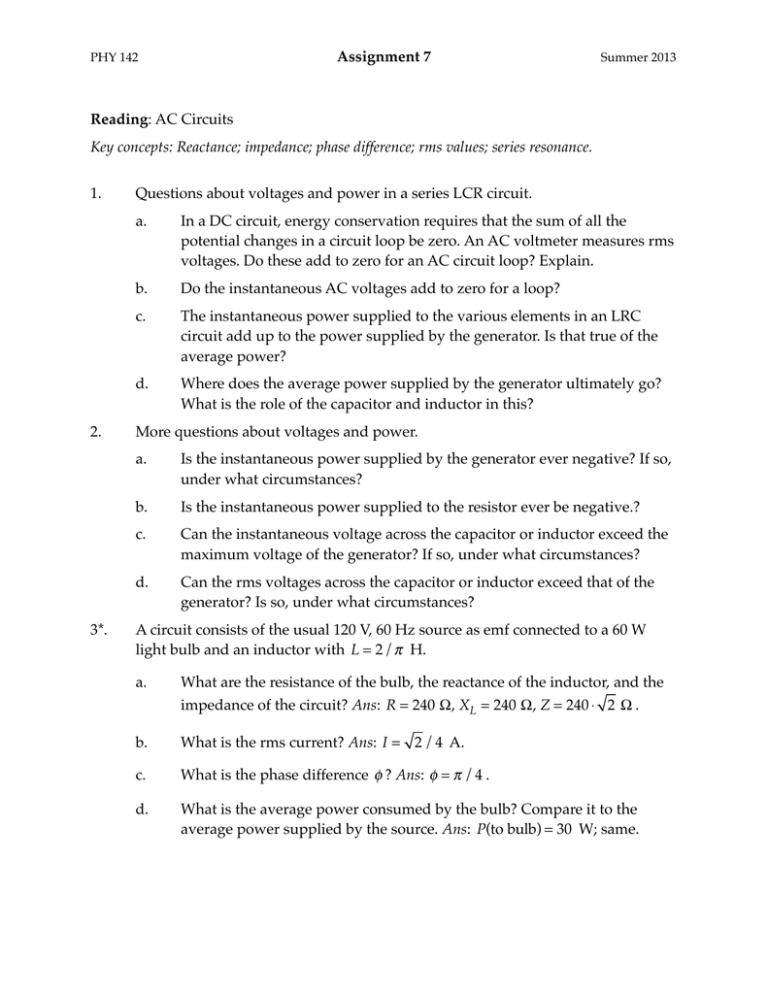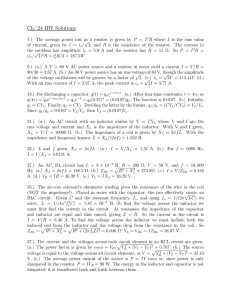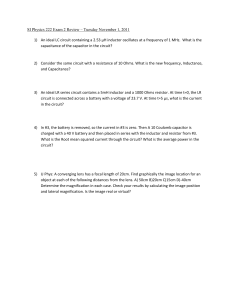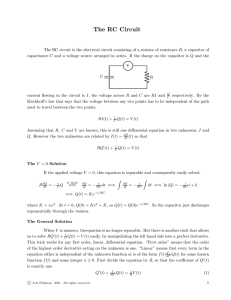Assignment 7 Reading ! 1.!
advertisement

PHY 142! Assignment 7! Summer 2013 Reading: AC Circuits Key concepts: Reactance; impedance; phase difference; rms values; series resonance. 1.! 2.! 3*.! Questions about voltages and power in a series LCR circuit. a.! In a DC circuit, energy conservation requires that the sum of all the potential changes in a circuit loop be zero. An AC voltmeter measures rms voltages. Do these add to zero for an AC circuit loop? Explain. b.! Do the instantaneous AC voltages add to zero for a loop? c.! The instantaneous power supplied to the various elements in an LRC circuit add up to the power supplied by the generator. Is that true of the average power? d.! Where does the average power supplied by the generator ultimately go? What is the role of the capacitor and inductor in this? More questions about voltages and power. a.! Is the instantaneous power supplied by the generator ever negative? If so, under what circumstances? b.! Is the instantaneous power supplied to the resistor ever be negative.? c.! Can the instantaneous voltage across the capacitor or inductor exceed the maximum voltage of the generator? If so, under what circumstances? d.! Can the rms voltages across the capacitor or inductor exceed that of the generator? Is so, under what circumstances? A circuit consists of the usual 120 V, 60 Hz source as emf connected to a 60 W light bulb and an inductor with L = 2/ π H. a.! What are the resistance of the bulb, the reactance of the inductor, and the impedance of the circuit? Ans: R = 240 Ω, XL = 240 Ω, Z = 240 ⋅ 2 Ω . b.! What is the rms current? Ans: I = 2 / 4 A. c.! What is the phase difference φ ? Ans: φ = π / 4 . d.! What is the average power consumed by the bulb? Compare it to the average power supplied by the source. Ans: P(to bulb) = 30 W; same. PHY 142! 4.! 5*.! Assignment 7! Summer 2013 In a series LCR circuit the rms generator voltage is 100 V, the resistor is 1 Ω , and the rms current is 0.1 A. a.! What average power is supplied by the generator? Ans: 0.01 W. b.! If the (rms) voltage across the inductor is greater than that across the capacitor, what is the phase angle φ for this circuit? Ans: tan φ ≈ 1000 . ! The tuner section of a radio is like a series LCR circuit, with the signal from the antenna playing the role of the AC generator. The tuner has resistance R = 1 Ω, capacitance C = 25 pF and inductance L = 0.01 H. a.! For what angular frequency from the antenna will the input power from the antenna be a maximum? Ans: ω = 2 × 106 Hz. b.! If the input (rms) voltage from the antenna is 1 mV, what is the power input to the circuit in this case? Ans: P = 10−6 W. c.! Suppose the input ω deviates slightly from the answer to (a) such that XL − XC = 200 Ω. If the input voltage remains the same, what is the input power from the antenna to the circuit in this case? Ans: P ≈ 2.5 × 10−11 W. d.! Show that the situation in (c) occurs if ω = 2.01 × 106 Hz. [Changing the frequency by 0.5 % reduces the power input by a factor of 4 × 10 4 .] 6.! The filter shown has a capacitor and a coil which has both inductance and resistance. The input rms voltage is Vin at angular frequency ω. The output rms voltage Vout is that across the coil. [It is equal to the rms current times the impedance of the coil.] 7.! C L Vin a.! Express the ratio Vout /Vin in terms of ω , C, L and R. b.! Is this a high-pass or a low-pass filter? How do you know? Vout R In the previous problem, suppose the coil and the capacitor are interchanged so that Vout is the voltage across the capacitor. Answer the same two questions. PHY 142! Assignment 7! Summer 2013 Reading: Electromagnetic Energy Key concepts: Poynting vector; intensity; energy flow; e-m waves and their properties. 8.! The fields of a moving point charge are quite complicated, especially if the charge is moving very fast, or is accelerating. But one can use some simple rules about directions for the fields of a charge moving at a constant velocity which is small compared to c. The E-field is not very different from that of a static charge, and the B-field is like that of a small bit of current, so the Biot-Savart law can be used by replacing I dl with q v . a.! 9*.! 10.! Consider a proton moving as shown. We are interested in the fields at point P, directly above the proton. Indicate the directions of E, B and S. P b.! Interpret the direction of S. Why is it reasonable that it be directed as you found in (a)? c.! Suppose the particle were an electron. Repeat the analysis of directions. v At the summer solstice the sun’s rays are perpendicular to the earth’s surface on the Tropic of Cancer, about 23° north latitude. At the winter solstice, those rays are perpendicular to the earth’s surface at the Tropic of Capricorn, about 23° south latitude. Durham is almost exactly 36° north latitude. a.! What is the angle that the sun’s rays make with the normal to the surface at Durham at the summer solstice? At the winter solstice? b.! Find the ratio of the intensity of sunlight on the surface at the winter solstice to that at the summer solstice, in Durham. The drawing shows a battery and a resistor. At each of the points shown indicate with an arrow the directions of E, B and S. + 1 • 2 • 3 • 4 • PHY 142! 11.! 13.! Summer 2013 The coaxial cable shown connects a battery and a resistor. The higher potential is on the inner conductor. Also shown is a crossR E section view of the cable, looking toward the resistor. You are to analyze the flow of power from the battery to the resistor through the cable. a.! 12.! Assignment 7! At the point shown in cross-section, indicate the directions of E, B and S. r b.! The magnitudes of the E- and B-fields were found earlier: ! ! ! Here a and b are the radii of the inner and outer conductors. Find the magnitude of the Poynting vector in terms of E and I. c.! Integrate the flux of S to find the power passing down the cable. [Use as element of area a circular ring of radius r and width dr.] Ans: P = EI . E= • µ I E 1 ⋅ , B= 0 . ln(b/ a) r 2π r The darker circle represents the cross-section of a solenoid carrying current supplied by a battery; the B-field within its windings is directed as shown. Around the solenoid, in the plane of the page, is a non-conducting ring (the lighter circle) of mass m and positive charge Q, uniformly distributed around the ring. Q B ⊗ P • a.! Suppose the battery is disconnected quickly. What direction (clockwise or counter-clockwise) is the induced E-field at the location of the ring? b.! Describe the motion of the ring. Consider the fields at point P shown, before the battery is disconnected. a.! What are the directions of E (due to the charged ring), B and S? b.! The momentum density of the fields is proportional to S. Describe the angular momentum of the fields in this situation. c.! The system of battery, solenoid and ring is closed, so angular momentum must be conserved if nothing is done from the outside. Relate this to the motion of the ring when the battery is disconnected. PHY 142! 14.! Assignment 7! Summer 2013 The wave equation in one spatial dimension can be written as ! ∂ 2E ! ∂x 2 = 1 ∂ 2E c 2 ∂t 2 . and similarly for B. a.! Show that any vector field of the form E(x,t) = n ⋅ f (x − ct) , where n is a constant unit vector, will satisfy the above equation. ! 15.! But the fields of e-m waves must also satisfy Maxwell’s equations. From Gauss’s law (for both E and B) one can show that neither field has an x-component (unless it is constant and uniform, certainly not the field of a wave). b.! Let E be in the y-direction. Apply Faraday’s law to the rectangular path shown, to show that ! ! c.! Use the definition of a derivative to show that, as dx → 0 , h ⋅[Ey (x + dx) − Ey (x)] = −h ⋅ dx ⋅ y dx h x ∂Bz . ∂t ∂Ey ∂x =− ∂Bz . ∂t Continuing the argument of the previous question. a.! Let Ey (x,t) = f (x − ct) so that it will satisfy the wave equation., and similarly let Bz (x,t) = g(x − ct) . Show that 14(c) requires f ′(x − ct) = c ⋅ g′(x − ct) , where the prime denotes differentiation with respect to the argument of the function. b.! Except for a possible constant field (again, not part of a wave), f = c ⋅ g , so we have Ey (x,t) = cBz (x,t) . Interpret this in terms of: (1) the relative directions of E, B and the direction the wave moves; (2) the relation between the magnitudes of E and B; (3) The relative behavior of the two fields as functions of x and t. ! [The arguments in these two problems show how the general properties of e-m waves are derived from the theory.]








